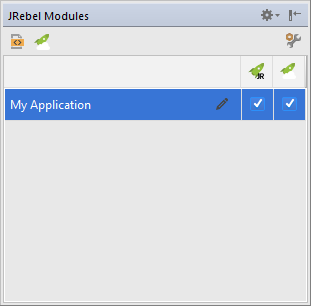

There’s nothing else to do to use JRebel. XX:+CMSClassUnloadingEnabled -XX:MaxPermSize=256m -Xmx1024M -Xss2M \ Java -Drebel.lift_plugin=true -noverify -javaagent:c:/opt/zt/jrebel/jrebel.jar \ `dirname $0`/sbt-launch-0.12.jar Windows, modify sbt.bat to be: set SCRIPT_DIR=%~dp0 Xmx1024M -Xss2M -XX:MaxPermSize=512m -XX:+CMSClassUnloadingEnabled -jar \ This means setting the -javaagent and -noverify flags for Java, and enabling the JRebel Lift plugin.įor Mac and Linux, the script that’s included with the Lift downloads would become: java -Drebel.lift_plugin=true -noverify -javaagent:/opt/zt/jrebel/jrebel.jar \
#JREBEL INTELLIJ SETUP LICENSE#
Click the “Activate” button, and once you see the license status change to “You have a valid myJRebel token,” click “Finish.”įinally, configure SBT by modifying the sbt script to enable JRebel. In the “Activation” setting, select “I want to use myJRebel” and then in the “License” section, paste in your activation token. To apply the token to your local install, run the JRebel configuration script : $ /opt/zt/jrebel/bin/jrebel-config.shįor Windows, navigate to and launch bin\jrebel-config.cmd. When you have received your account confirmation email from JRebel, you can copy your “authentication token” from the “Active” area of ZeroTurnaround’s site. For this recipe, I’ve chosen to use /opt/zt/jrebel/.
#JREBEL INTELLIJ SETUP ZIP#
Second, download the “Generic ZIP Archive” version of JRebel, unzip it to where you like.
#JREBEL INTELLIJ SETUP INSTALL#
There are three steps required: install JRebel once each year, request the free Scala license and configure SBT to use JRebel.įirst, visit and request the free Scala license. If you’re seeing this error often, check the setting for -XX:MaxPermSize inside the sbt (or sbt.bat) script, and if you can, double it.

The best you can do is stop and then restart SBT.

As you might imagine, continually restarting a container causes many classes to be loaded and unloaded, but the process is not perfect, effectively leaking memory. It’s a fixed size, and once it is full, this PermGen error appears. It’s the area of memory used for storing classes (amongst other things). The permanent generation is a Java Virtual Machine concept. One error you may run into is: : PermGen space That takes some of the tedium out of these long commands. The SBT console has a command history, and using the up and down keyboard arrows allows you to navigate to previous commands and run them by pressing the Return key. This will prevent SBT compiling and restarting your application over and over. However, if you are making a serious number of edits, you may prefer to issue a container:stop command until you’re ready to run you application again with container:start. The need for restarts by integrating JRebel into your development environment, as described Restarting the web container each time you edit a Scala file isn’t ideal. This works out just fine, because Jetty will use your modified HTML file when you Scala and Java source file changes, and also changes to files in src/main/resources/. This is because SBT’s default behaviour is to look for (press enter to interrupt)Įdits to HTML files don’t trigger the SBT compile and reload commands. Luckily, only five small files are needed.įirst, create an SBT plugin file at project/plugins.sbt (all filenames are given relative to the project root directory): libraryDependencies v match You will need to configure SBT and the Lift project yourself.


 0 kommentar(er)
0 kommentar(er)
